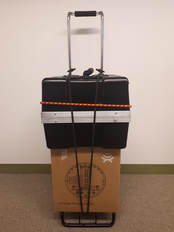Additional Projects

The Travelling Human Subject Study (THSS)
A goal of most multi-site studies is to literally merge the data from several scanners in order to increase the sample size applied to a substantive question of interest. Accordingly, merging data is only reasonable if both within-site and between-site scanner differences in MRI results can be minimized, and are reliable from one occasion to the next.
The major goal of "The Travelling Human Subject Study" is to identify and assess the potential sources of variance among twelve magnetic resonance (MR) scanners in Ontario. This will be accomplished by scanning ten participants once at eleven MR sites and twice at the twelfth site (i.e., Baycrest Centre), using the same ONDRI-based scanning protocol procedure for every session. In addition, two phantom objects will be scanned twice at each of the twelve MRI sites.
This study is being lead by Dr. Stephen Strother and Dr. Stephen Arnott. For more information, please contact Stephen Arnott by phone at 416-785-2500 ext. 2335, or by email at: [email protected]
HPD and SDP Phantoms:
The two phantoms used in the THSS include a system phantom created by High Precision Devices (HPD) and a diffusion tensor specific phantom created by Synaptive (SDP). The HPD phantom consists of a spherical casing roughly the size of a human head, further divided up with three layers (T1, T2, proton density (PD)) of 14 smaller spheres of different contrasts designed for more precise measurements of scanner resolution and measurements of T1, T2 and geometry. Scanning of this phantom followed the same protocol as the human participants for 3DT1 and PD/T2 scans.
In contrast, multiple diffusion tensor imaging (DTI) scans were collected at different resolutions and with a different number of directions for the SDP phantom, in addition to those used for the human participant. This phantom contains a series of artificial tracts designed to simulate different orientations of white matter fibre bundles in the human brain, which would allow for comparison of these measurements obtained under different scanning conditions.
A goal of most multi-site studies is to literally merge the data from several scanners in order to increase the sample size applied to a substantive question of interest. Accordingly, merging data is only reasonable if both within-site and between-site scanner differences in MRI results can be minimized, and are reliable from one occasion to the next.
The major goal of "The Travelling Human Subject Study" is to identify and assess the potential sources of variance among twelve magnetic resonance (MR) scanners in Ontario. This will be accomplished by scanning ten participants once at eleven MR sites and twice at the twelfth site (i.e., Baycrest Centre), using the same ONDRI-based scanning protocol procedure for every session. In addition, two phantom objects will be scanned twice at each of the twelve MRI sites.
This study is being lead by Dr. Stephen Strother and Dr. Stephen Arnott. For more information, please contact Stephen Arnott by phone at 416-785-2500 ext. 2335, or by email at: [email protected]
HPD and SDP Phantoms:
The two phantoms used in the THSS include a system phantom created by High Precision Devices (HPD) and a diffusion tensor specific phantom created by Synaptive (SDP). The HPD phantom consists of a spherical casing roughly the size of a human head, further divided up with three layers (T1, T2, proton density (PD)) of 14 smaller spheres of different contrasts designed for more precise measurements of scanner resolution and measurements of T1, T2 and geometry. Scanning of this phantom followed the same protocol as the human participants for 3DT1 and PD/T2 scans.
In contrast, multiple diffusion tensor imaging (DTI) scans were collected at different resolutions and with a different number of directions for the SDP phantom, in addition to those used for the human participant. This phantom contains a series of artificial tracts designed to simulate different orientations of white matter fibre bundles in the human brain, which would allow for comparison of these measurements obtained under different scanning conditions.

Toronto Dementia Research Alliance Database
Our lab assists the Toronto Dementia Research Alliance with their Dementia Clinical Research Database. This project embeds a research platform within clinical care. Dr. Strother is a Principal Investigator on the Brain Canada grant that funds this project.
The Toronto Cognitive Assessment (TorCA) (previously named Behaviourial Neurology Assessment Revised [BNA-R]) is a standardized cognitive assessment designed as an in depth tool that is an intermediate between short screening tests such as the MMSE and MoCA, and the more lengthy neuropsychological assessments. This test can be administered by physicians, nurses and other allied health staff. The TorCA is meant to detect early changes in cognition, such as mild cognitive impairment (MCI), which can be missed using simpler screening tools.
Members of the Strother Lab designed and programmed an electronic version of the TorCA on a program called FileMaker, which allows the test to be administered to patients on an iPad by a health care practitioner. We also created linkage to an OpenClinica database, where this data can be hosted and stored. This configuration is presently used in the memory clinic at Baycrest, and is being implemented in the future at CAMH, UHN and Sunnybrook hospitals.
The Toronto Dementia Research Alliance (TDRA) platform will create a database for research studies embedded in clinical care through development of a unified approach for diagnosis and charting of the natural history of pure and mixed dementias, along with the impact of co-occurring disorders. This project brings together leading TDRA clinicians and investigators in cognitive evaluation and management of subjects with neurodegenerative and vascular cognitive disorders drug development, clinical trials, epidemiology, health services, statistics, neuroinformatics and brain imaging. The five University of Toronto affiliated hospitals that house memory clinics comprise the TDRA, where approximately 6,000 patients are seen annually (2,000 new patients and 4,000 follow-up patients). The initial outcome will be a database of patients seen across the TDRA memory clinics, at time of first assessment and then at follow-up, with plans to expand to other centers in Ontario and nationally.
Our lab assists the Toronto Dementia Research Alliance with their Dementia Clinical Research Database. This project embeds a research platform within clinical care. Dr. Strother is a Principal Investigator on the Brain Canada grant that funds this project.
The Toronto Cognitive Assessment (TorCA) (previously named Behaviourial Neurology Assessment Revised [BNA-R]) is a standardized cognitive assessment designed as an in depth tool that is an intermediate between short screening tests such as the MMSE and MoCA, and the more lengthy neuropsychological assessments. This test can be administered by physicians, nurses and other allied health staff. The TorCA is meant to detect early changes in cognition, such as mild cognitive impairment (MCI), which can be missed using simpler screening tools.
Members of the Strother Lab designed and programmed an electronic version of the TorCA on a program called FileMaker, which allows the test to be administered to patients on an iPad by a health care practitioner. We also created linkage to an OpenClinica database, where this data can be hosted and stored. This configuration is presently used in the memory clinic at Baycrest, and is being implemented in the future at CAMH, UHN and Sunnybrook hospitals.
The Toronto Dementia Research Alliance (TDRA) platform will create a database for research studies embedded in clinical care through development of a unified approach for diagnosis and charting of the natural history of pure and mixed dementias, along with the impact of co-occurring disorders. This project brings together leading TDRA clinicians and investigators in cognitive evaluation and management of subjects with neurodegenerative and vascular cognitive disorders drug development, clinical trials, epidemiology, health services, statistics, neuroinformatics and brain imaging. The five University of Toronto affiliated hospitals that house memory clinics comprise the TDRA, where approximately 6,000 patients are seen annually (2,000 new patients and 4,000 follow-up patients). The initial outcome will be a database of patients seen across the TDRA memory clinics, at time of first assessment and then at follow-up, with plans to expand to other centers in Ontario and nationally.
|
Rotman Research Institute | Baycrest
3560 Bathurst Street, North York Ontario, Canada M6A 2E1 |

